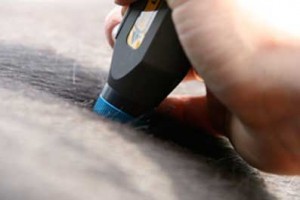Low Level Laser Therapy (LLLT) utilises infra red light to therapeutically treat cells in the body whose function is compromised or which are “working” at a reduced level.
All cells respond to light energy – the effect of light upon tissue is known as photobiomodulation – and depending on the intensity (depth) and wavelength of the light which is applied, different physiological processes will be promoted.
This means that LLLT can be used to treat a very wide variety of problems, from acute wounds to arthritic conditions.
Laser may be utilised in many situations including the following:
Acute inflammation (reduction of oedema, promotion of tissue permeability)
Treatment of open wounds and ulcers (including wound margins and wound beds)
Treatment of acupressure points, trigger points and muscle spasm
Arthritic conditions and degenerative disorders
Musculoskeletal disorders (ligament or tendon strain; bursal enlargements; neuralgic pain; acute or chronic muscular conditions)
Fracture repair
Foot injuries: abcesses, laminitis, bruised soles and corns
Effect of LLLT
Tissue which has been treated by LLLT has been shown to have undergone an enhanced healing process; having greater tensile strength resulting from increased fibroblast activity (and therefore collagen production), minimising adhesions and scarring particularly when applied in the early stages of healing.
Non-healing wounds and scar tissue also respond well to LLLT showing increased vascularisation, neutralisation of infection and re-stimulation of the healing process (see below for photographic sequence following wound healing process). LLLT-stimulated release of serotonin, endorphins and encephalins produces a long lasting analgesic effect, reducing pain. C-afferent fibres are also stimulated which invoke the “pain gate” mechanism, reducing trigger point muscle spasm and related muscular pain and inhibition.
Application of Low Level Laser Therapy (LLLT)
LLLT is applied via instruments called “probes”.
Helen uses a 820nm 200MW single probe and a 20-cluster LED probe. Greater energy density is provided by the single probe, but the LED cluster is used to irradiate a wider area, “joining up” the points treated by the single probe to provide full area coverage.
Each probe is cleaned with antiseptic wipes before treatment and a barrier method of application is used (treating through clear film) to minimise risk of cross-contamination between patients.
Laser has a non-heating (non-thermal) biochemical effect. It is therefore one of the safest electrotherapy modalities available and will not cause damage to tissue. Much research work at a cellular level, and in animal/ human studies has been undertaken in the last twenty years which provides a scientific basis for the clinical application of laser in tissue repair and pain relief.

